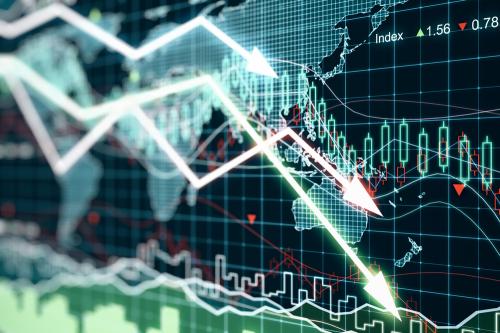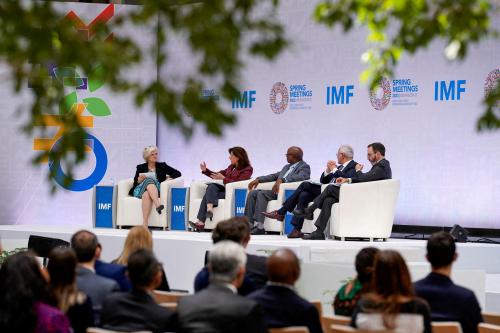The global economy is in the midst of a sudden slowdown accompanied by a steep run-up in global inflation to multidecade highs. These developments raise concerns about stagflation—the coincidence of weak growth and elevated inflation—similar to what the world suffered in the 1970s. That experience should be warning of the damage this could wreak on emerging market and developing economies (EMDEs). The stagflation of that era ended with a global recession and a series of financial crises in EMDEs. In light of the lessons of that stagflation episode, these economies need to do a quick rethink of policies to cope with the consequences of rapidly tightening global financing conditions.
Inflation and growth: moving in opposite directions
In May 2022, global inflation (8.1 percent) and EMDE inflation (9.4 percent) were at their highest levels since 2008. Inflation in advanced economies reached its highest level recorded during the last four decades. As recent shocks in energy and food prices recede, supply bottlenecks ease, and financial conditions tighten, global inflation is expected to decline to about 3 percent next year. But this would still be about 1 percentage point above its average in 2019, before the pandemic turned the world upside down.
After collapsing during the 2020 global recession, global growth rebounded to 5.7 percent in 2021, supported by unprecedented fiscal and monetary policy accommodation. However, growth is now expected to slow to 2.9 percent in 2022 with little change in 2023-24 because of the war in Ukraine, the fading of pent-up demand, and the withdrawal of policy support amid high inflation. Beyond the near-term, global growth is expected to remain subdued over the 2020s, reflecting a trend weakening of the fundamental drivers of growth.
The growth slowdown is steeper, inflation increases not quite as bad (yet)
The current juncture resembles the early 1970s in three key respects:
- Elevated inflation and weak growth. The global economy has been emerging from the pandemic-related global recession of 2020, just as it did during the stagflationary period after the global recession in 1975. Global inflation during 1973-83 averaged 11.3 percent a year, more than three times as high as the average of 3.6 percent a year during 1962-72. While the inflation run-up since the 2020 global recession triggered by the COVID-19 pandemic has been less steep than after the 1975 recession, the projected growth slowdown is much steeper. Between 2021 and 2024, global growth is projected to slow by 2.7 percentage points, more than twice as much as between 1976 and 1979 (Figure 1).
- Supply shocks after prolonged monetary policy accommodation. Supply disruptions driven by the pandemic and the recent supply shock dealt to global energy and food prices by Russia’s invasion of Ukraine resemble the oil shocks in 1973 and 1979-80. Increases in energy prices in the 1970s and during the period 2020-22 have constituted the largest changes in prices of the past 50 years. Then and now, monetary policy generally was highly accommodative in the run-up to these shocks, with interest rates negative in real terms for several years.
- Significant vulnerabilities in emerging market and developing economies (EMDEs). In the 1970s and early 1980s, as now, high debt, elevated inflation, and weak fiscal positions made EMDEs vulnerable to tightening financial conditions. The stagflation of the 1970s coincided with the first global wave of debt accumulation in the past half-century. Low global real interest rates and the rapid development of syndicated loan markets encouraged a surge in EMDE debt, especially in Latin America and many low-income countries. The 2010s featured the fourth (and current) wave of global debt accumulation involving the largest, fastest, and most broad-based increase in government debt by EMDEs in the past 50 years. A number of LICs are already either in or near debt distress. The sheer magnitude and speed of the debt buildup heightens the associated risks.
Figure 1. Developments in the 1970s and 2020s: Similarities
A. Slowdown in growth after global recessions

B. CPI inflation

C. Real interest rates

D. Change in food and energy prices
 Sources: Federal Reserve Economic Data; Haver Analytics; World Bank.
Sources: Federal Reserve Economic Data; Haver Analytics; World Bank.
Notes: CPI = consumer price index; EMDEs = emerging market and developing economies. A. Figure shows changes in global growth (in percentage points) between 2021-24 and 1976-79; covers three years following a rebound from a global recession; B. Annual averages of headline and core CPI inflation in the United States and global (average across 66 countries). 2022 is based on the averages of January to May 2022; C. Figure shows nominal and real (CPI-adjusted) short-term interest rates (Treasury bill rates or money market rates, with the maturity of three months or less). Global interest rates are weighted by GDP in U.S. dollars. Sample includes 113 countries, though the sample size varies by year; D. Percent change in monthly energy and food price indices over a 24-month period. Because of data limitations, prior to 1979, the energy price change is proxied using the oil price change.
Critical differences from the 1970s
While the similarities outlined above are worrying, there are important cyclical and structural differences between the 1970s and the current situation. These mean that the global economy could yet escape a repeat of that stagflation episode.
- Smaller shocks. At least thus far, the magnitude of commodity price jumps has been smaller than in the 1970s. For now, global inflation in 2022 is still less broad-based than it was in the 1970s, and core inflation has remained moderate in many countries, even if it has recently picked up.
- More credible monetary policy frameworks. Monetary policy frameworks have become increasingly focused on price stability over time. In the 1970s, central banks often faced competing objectives—aiming for both high output and employment, as well as for price stability. In contrast, central banks in advanced economies and many EMDEs now have clear mandates for price stability, typically expressed as an explicit inflation target (Figure 2). As a result of improvements in policy frameworks and better anchored inflation expectations, inflation—in particular core inflation—has become much less sensitive to inflation surprises.
- More flexible economies. The 1970s were a time of considerable structural economic rigidities, many of which have since evolved. Today’s greater economic flexibility, with less centralized wage setting and less financial repression, allows a faster supply and demand response in sectors where prices are rising particularly rapidly and reduces the likelihood of price-wage spirals becoming entrenched. In addition, the energy intensity of GDP has fallen considerably since the 1970s, making economies more resilient to shocks in energy prices (World Bank 2022a).
- Less fiscal accommodation. The 1960s and 1970s were marked by expansionary fiscal policy. In contrast, fiscal policy tightening is expected in coming years as governments withdraw the unprecedented fiscal support provided during the pandemic.
Figure 2. Developments in the 1970s and 2020s: Differences
A. Number of countries with inflation targeting

B. Labor market flexibility

C. US inflation expectations

D. Global energy intensity

Notes: TOE=Tonnes of oil equivalent. A. Based on the clarification of IMF Annual Report on Exchange Arrangements and Exchange Restrictions and country-specific sources; B. Collective bargaining rates indicate percent of employees with bargaining powers. Trade union density rates indicate the number of union members as a percent of total employees. Aggregation is based on median across a balanced set of 25 economies; C. U.S. consumer inflation expectations based on April 2022 University of Michigan survey; D. Energy includes coal, natural gas, and oil. TOE stands for tonnes (metric tons) of oil equivalent. Aggregates calculated using GDP weights at average 2010-19 prices and market exchange rates.
A sluggish response to serious risks
Concerns about persistently above-target inflation have already prompted central banks in most advanced economies and many EMDEs to tighten monetary policy amid a sharp growth slowdown. Despite this tightening, as of May 2022, real policy rates (adjusted by actual inflation) remain deeply negative in the average advanced economy (-5.2 percent) and in the average EMDE (-3.2 percent).
If inflation expectations de-anchor, as they did in the 1970s, because of persistently elevated inflation and repeated inflationary shocks, the interest rate increases required to bring inflation back to target in advanced economies will be greater than those currently anticipated by financial markets. This raises the specter of the steep increases in interest rates that brought inflation under control but also triggered a global recession in 1982. That global recession also coincided with a string of financial crises and marked the beginning of a protracted period of weak growth in many EMDEs.
If current stagflationary pressures intensify, EMDEs would likely face economic danger again because of their less weakly-anchored inflation expectations, elevated financial vulnerabilities, and dwindling growth prospects. This makes it urgent for their governments to shore up their fiscal and external buffers to stave off potential contagion, strengthen their monetary policy frameworks to reduce policy uncertainty, and implement structural policies to reinvigorate growth.









Commentary
Today’s global economy is eerily similar to the 1970s, but governments can still escape a stagflation episode
July 1, 2022